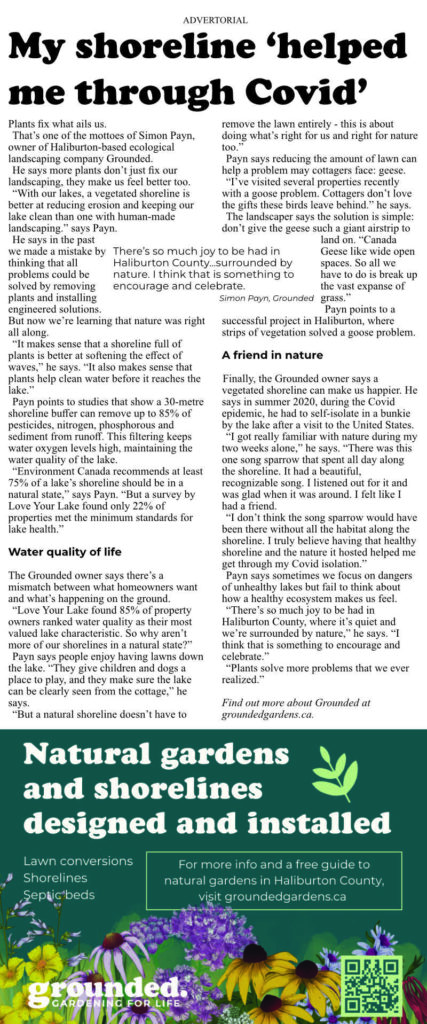
My Haliburton Cottage Shoreline Helped Me Through Covid
Haliburton cottage shorelines do more than keep the lake healthy. The nature they attract keeps us feeling good too.
Plants fix what ails us.
That’s one of the mottoes of Simon Payn, owner of Haliburton-based ecological landscaping company Grounded.
He says more plants don’t just fix our landscaping, they make us feel better too.
“With our lakes, a vegetated shoreline is better at reducing erosion and keeping our lake clean than one with human-made landscaping.” says Payn.
He says in the past we made a mistake by thinking that all problems could be solved by removing plants and installing engineered solutions. But now we’re learning that nature was right all along.
“It makes sense that a shoreline full of plants is better at softening the effect of waves,” he says. “It also makes sense that plants help clean water before it reaches the lake.”
Payn points to studies that show a 30-metre shoreline buffer can remove up to 85% of pesticides, nitrogen, phosphorous and sediment from runoff. This filtering keeps water oxygen levels high, maintaining the water quality of the lake.
“Environment Canada recommends at least 75% of a lake’s shoreline should be in a natural state,” says Payn. “But a survey by Love Your Lake found only 22% of properties met the minimum standards for lake health.”
Haliburton cottage shoreline health
The Grounded owner says there’s a mismatch between what homeowners want and what’s happening on the ground.
“Love Your Lake found 85% of property owners ranked water quality as their most valued lake characteristic. So why aren’t more of our shorelines in a natural state?”
Payn says people enjoy having lawns down the lake. “They give children and dogs a place to play, and they make sure the lake can be clearly seen from the cottage,” he says.
“But a natural shoreline doesn’t have to remove the lawn entirely – this is about doing what’s right for us and right for nature too.”
Payn says reducing the amount of lawn can help a problem may cottagers face: geese.
“I’ve visited several properties recently with a goose problem. Cottagers don’t love the gifts these birds leave behind.” he says.
The landscaper says the solution is simple: don’t give the geese such a giant airstrip to land on. “Canada Geese like wide open spaces. So all we have to do is break up the vast expanse of grass.”
Payn points to a successful project in Haliburton, where strips of vegetation solved a goose problem.
Healthy in more ways that one
Finally, the Grounded owner says a vegetated shoreline can make us happier. He says in summer 2020, during the Covid epidemic, he had to self-isolate in a bunkie by the lake after a visit to the United States.“
I got really familiar with nature during my two weeks alone,” he says. “There was this one song sparrow that spent all day along the shoreline. It had a beautiful, recognizable song. I listened out for it and was glad when it was around. I felt like I had a friend.
“I don’t think the song sparrow would have been there without all the habitat along the shoreline. I truly believe having that healthy shoreline and the nature it hosted helped me get through my Covid isolation.”
Payn says sometimes we focus on dangers of unhealthy lakes but fail to think about how a healthy ecosystem makes us feel.
“There’s so much joy to be had in Haliburton County, where it’s quiet and we’re surrounded by nature,” he says. “I think that is something to encourage and celebrate.”
“Plants solve more problems that we ever realized.”
This advertorial first appeared in The Highlander on July 25, 2024.
